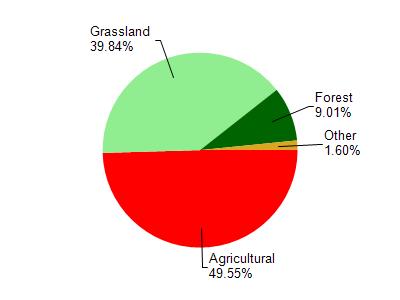Iowa
Yes
No
No
Fish and Aquatic Life
Overview
This small creek originates south of the Villiage of Rewey. The sewerage treatment plant works for the village discharges to an unnamed tributary about one-half mile upstream from its confluence with the Williams-Rewey Branch. The creek is classified as a Class II trout fishery for most of its length and has the potential to be a Class I stream (Simms). There was some concern that discharge from the treatment plant would potentially affect the trout fishery (Van Dyke memo). However, the flow rates and distance from the discharge to the river tend to mitigate any effects (B. Moore, memo). A gamefish survey was conducted in 2001 and found that brook trout are naturally reproducing in this stream.
Date 2002
Author Aquatic Biologist
Historical Description
Williams Creek (Rewey) - Mouth location T4N R1E Section 14 -7, Surface area = 1.3 acres, Length = 2.0 miles, Gradient = 44.8 feet per mile, Total alkalinity = 284.0 mg/l, Volume of flow = 1.5 cfs.
Williams Creek is considered as a spring fed stream and marginal trout water. About 81 percent of its watershed is cleared for agricultural purposes. This principal land use is reflected in the rapid runoff of surface waters and subsequent heavy bank erosion and siltation. There is a possible source of pollution in a creamery located at its headwaters. The sport fishery consists of brown trout which are stocked annually. Forage fish species present include white suckers, bluntnose minnows, common shiners, bigmouth shiners, stoneroller minnows, redbelly dace, creek chubs, and johnny darters. There are no public lands but is accessible from two road crossings.
From: Piening, Ronald and Threinen, C.W., 1968. Lake and Stream Classification Project. Surface Water Resources of
Iowa County, Wisconsin Department of Natural Resources, Madison, WI.
Date 1968
Author Surface Water Inventory Of Wisconsin
Condition
Wisconsin has over 84,000 miles of streams, 15,000 lakes and milllions of acres of wetlands. Assessing the condition of this vast amount of water is challenging. The state's water monitoring program uses a media-based, cross-program approach to analyze water condition. An updated monitoring strategy (2015-2020) is now available. Compliance with Clean Water Act fishable, swimmable standards are located in the Executive Summary of Water Condition in 2018. See also the 'monitoring and projects' tab.
Reports
Management Goals
Wisconsin's Water Quality Standards provide qualitative and quantitative goals for waters that are protective of Fishable, Swimmable conditions [Learn more]. Waters that do not meet water quality standards are considered impaired and restoration actions are planned and carried out until the water is once again fishable and swimmable
Management goals can include creation or implementation of a Total Maximum Daily Load analysis, a Nine Key Element Plan, or other restoration work, education and outreach and more. If specific recommendations exist for this water, they will be displayed below online.
Monitoring
Monitoring the condition of a river, stream, or lake includes gathering physical, chemical, biological, and habitat data. Comprehensive studies often gather all these parameters in great detail, while lighter assessment events will involve sampling physical, chemical and biological data such as macroinvertebrates. Aquatic macroinvertebrates and fish communities integrate watershed or catchment condition, providing great insight into overall ecosystem health. Chemical and habitat parameters tell researchers more about human induced problems including contaminated runoff, point source dischargers, or habitat issues that foster or limit the potential of aquatic communities to thrive in a given area. Wisconsin's Water Monitoring Strategy was recenty updated.
Grants and Management Projects
Monitoring Projects
| WBIC | Official Waterbody Name | Station ID | Station Name | Earliest Fieldwork Date | Latest Fieldwork Date | View Station | View Data |
|---|
|
|

Watershed Characteristics
Williams-Rewey Br is located in the Upper West Branch Pecatonica River watershed which is 77.75 mi². Land use in the watershed is primarily agricultural (49.50%), grassland (39.80%) and a mix of forest (9%) and other uses (1.60%). This watershed has 184.74 stream miles, 21.81 lake acres and 293.60 wetland acres.
Nonpoint Source Characteristics
This watershed is ranked Not Available for runoff impacts on streams, Not Available for runoff impacts on lakes and High for runoff impacts on groundwater and therefore has an overall rank of High. This value can be used in ranking the watershed or individual waterbodies for grant funding under state and county programs.However, all waters are affected by diffuse pollutant sources regardless of initial water quality. Applications for specific runoff projects under state or county grant programs may be pursued. For more information, go to surface water program grants.